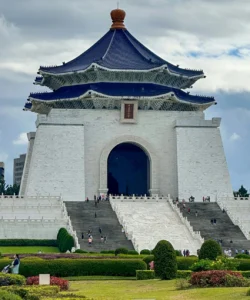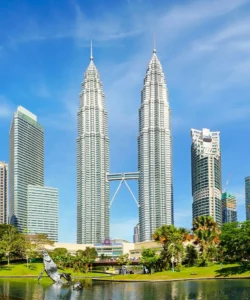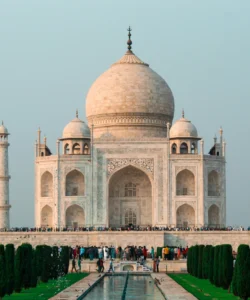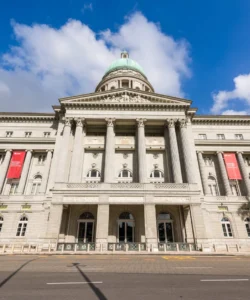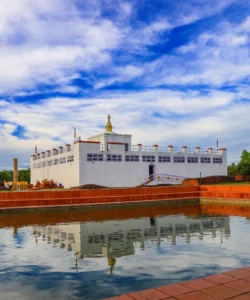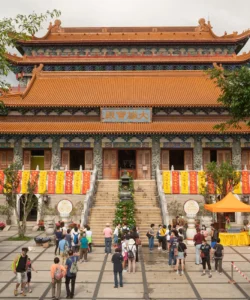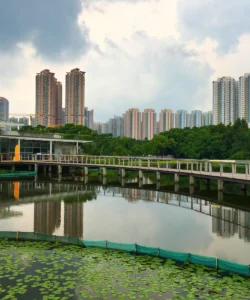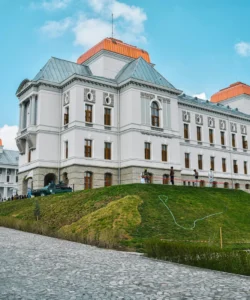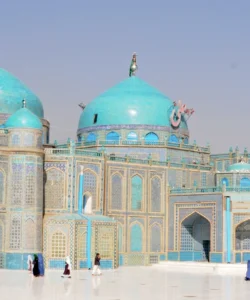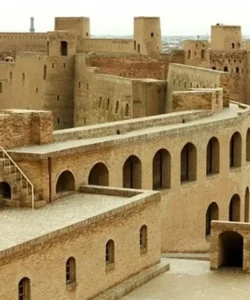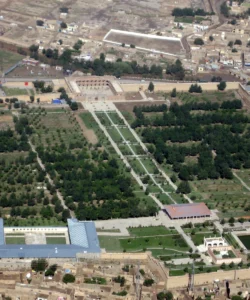The Blue Mosque, officially known as the Mausoleum of Ali or the Shrine of Hazrat Ali, is a magnificent and deeply revered mosque located in the city of Mazar-i-Sharif in northern Afghanistan. It is one of the most stunning examples of Islamic architecture in the region, famous for its dazzling blue tilework, spiritual significance, and the peaceful atmosphere created by its thousands of white pigeons.
Name: The Blue Mosque (Persian: مسجد کبود, Masjid-e Kabud; also Shrine of Hazrat Ali, or Mausoleum of Imam Ali, and in some historical contexts, Sultan Ahmed Mosque). The city of Mazar-i-Sharif itself means “Noble Shrine,” a direct reference to this monument.
Address: The mosque is situated in the heart of Mazar-i-Sharif, Balkh Province, Afghanistan. It is a central part of the city’s urban fabric and a key landmark.
How to Get There:
Travel to Mazar-i-Sharif is currently extremely difficult and unsafe for general tourism due to the political instability in Afghanistan. The following information is for historical context and is not a recommendation for travel.
- By Air: The closest airport is Mazar-i-Sharif International Airport (MZR).
- By Road: Mazar-i-Sharif is a major city in northern Afghanistan and is connected by road to other parts of the country, though travel can be dangerous.
- Within the City: In more stable times, the mosque was a central point in the city, easily accessible by walking or local transport.
- Entrance Fee: There is no entrance fee to the mosque complex.
- Dress Code: As a sacred Islamic site, modest dress is required for both men and women. Women should cover their heads, arms, and legs.
- Best Time to Visit: The cooler, dry months (September to May) are ideal. The mosque is particularly vibrant during the celebration of Nowruz (Persian New Year), when thousands of pilgrims gather for the Jahenda Bala ceremony, where a sacred flag is raised.
Landscape and Architecture:
The Blue Mosque is a stunning example of Timurid architecture, blending intricate tilework with a serene and spiritual setting.
- Central Shrine and Complex: The mosque is a sprawling complex built around a central tomb, believed by many to be the final resting place of Ali ibn Abi Talib, the cousin and son-in-law of Prophet Muhammad. The mosque was built in its current form in the 15th century by Timurid Sultan Husayn Bayqarah Mirza.
- Blue Tilework: The most iconic feature is its exterior, which is almost entirely covered in polychrome tile mosaic and painted tile panels, dominated by beautiful shades of blue (cobalt, turquoise, and azure). These intricate tiles are arranged in elaborate floral and geometric patterns, creating a mesmerizing visual tapestry that gives the mosque its famous name.
- Two Magnificent Domes: The mosque is crowned with two magnificent blue cupolas or domes. The largest one sits over the central tomb chamber, creating a grand and majestic interior space. These domes are a hallmark of Timurid architecture, known for its focus on soaring, domed structures.
- Minarets and Towers: The complex features a number of minarets and towers, all adorned with the same intricate blue tilework, which contributes to the mosque’s magnificent and imposing skyline.
- White Paved Courtyard: The mosque is set within a large, enclosed public space with a brightly white-tiled or paved courtyard. This white expanse provides a beautiful contrast to the deep blue of the mosque, and is a gathering place for thousands of white pigeons.
- The White Pigeons: The mosque is famously known for its resident population of thousands of pure white pigeons. According to local legend, any dove with a speck of color on its feathers will instantly turn pure white upon entering the mosque’s precinct due to its sanctity.
- Blend of Styles: The mosque showcases a blend of Islamic, Timurid, and Seljuk architectural styles, reflecting its long history of destruction and rebuilding over the centuries.
What Makes It Famous:
- Believed Tomb of Ali ibn Abi Talib: It is widely believed to be the final resting place of Ali ibn Abi Talib, the fourth Caliph of Sunni Islam and the first Imam of Shia Islam. While Shia Muslims generally believe he is buried in Najaf, Iraq, this purported tomb has made the mosque one of the most sacred pilgrimage sites in Afghanistan for both Sunni and Shia Muslims.
- Exquisite Blue Tilework: The mosque is world-renowned for its stunning blue tilework, which is a masterpiece of Timurid craftsmanship and a visual spectacle that draws pilgrims and admirers of Islamic art.
- Symbol of Peace and Purity: The thousands of resident white pigeons are a powerful symbol of peace, purity, and sanctity, creating a serene and captivating atmosphere.
- Cultural and Social Hub: The mosque is the most important civic space in Mazar-i-Sharif, serving not only as a religious and pilgrimage site but also as a place of education, social gatherings, and a center for festivals like Nowruz.
- Historical Resilience: The mosque has a long history of being destroyed and rebuilt. The first shrine was built by Sultan Ahmed Sanjar in the 11th century, then destroyed by Genghis Khan, and later rebuilt in a grander fashion by Sultan Husayn Mizra in the 15th century, highlighting the resilience of its spiritual significance.
Differences from Some Other Wonders:
- Contested Tomb of Ali: The most significant difference from other tombs or religious sites is that the Blue Mosque is built around a purported tomb of Ali ibn Abi Talib, whose actual burial place is contested and widely believed by Shia Muslims to be in Najaf, Iraq. This historical and religious ambiguity adds a unique layer of legend and folklore to the site.
- Timurid Architectural Style and Blue Tilework: While many mosques are famous for their architecture (e.g., the Badshahi Mosque in Lahore is Mughal), the Blue Mosque in Mazar-i-Sharif is a quintessential example of Timurid architecture, renowned for its vibrant blue and polychrome tilework, a style distinct from others.
- White Pigeons as an Iconic Feature: While pigeons are found in many places, the sheer volume and iconic purity of the thousands of white pigeons that inhabit the mosque’s courtyard are a unique and famous aspect of this site, deeply integrated into local legend and the visitor experience.
- Central Civic Space: The mosque is not just a place of worship; its central location and large, open courtyard have made it an important civic space for public gatherings and festivals, a role that distinguishes it from more secluded or purely religious sites.
- Symbol of a City’s Name: The city of Mazar-i-Sharif is named after the mosque itself (meaning “Noble Shrine”), highlighting the profound and inseparable link between the city’s identity and this single monument.
- “Living” Sanctuary in a War-Torn Region: The mosque has been fortunate to largely escape the direct devastation of modern conflicts in Afghanistan, standing as an oasis of peace and beauty in a region often associated with war, making its preservation a powerful symbol of hope.
Blue Mosque Photos:






























